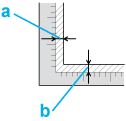 |
 |
|
||
 |
||||
Scan Quality Problems
The Edges of Your Original Are Not Scanned
If you are scanning in Full Auto Mode, or using thumbnail preview in Home Mode or Professional Mode, move the document or photo about 6 mm (0.2 inch) away from the horizontal and vertical edges of the document table to avoid cropping.
If you are scanning using normal preview in Office Mode, Home Mode, or Professional Mode, move the document or photo about 3 mm (0.12 inch) away from the horizontal and vertical edges of the document table to avoid cropping.

You See Only a Few Dots in Your Scanned Image
Make sure the document or photo is placed on the document table with the side to be scanned facing down. See Placing Documents or Photos for details.
When scanning with the Black&White setting in Office Mode or Home Mode, or the Black & White setting in Professional Mode, change the Threshold setting. See Adjusting the Color and Other Image Settings for instructions.
A Line or Line of Dots Always Appears in Your Scanned Images
The document table or transparency unit window may need cleaning. Clean the document table. See Cleaning the Scanner.
If you still have the problem, the document table or transparency unit window may be scratched. Contact your dealer for assistance. See Your Dealer.
Straight Lines in Your Image Come Out Crooked
Make sure the document lies perfectly straight on the document table.
Your Image Is Distorted

Make sure the document or photo lies flat on the document table. Also make sure your document or photo is not wrinkled or warped.
Make sure you do not move the document or photo, or your scanner while scanning.
Make sure the scanner is placed on a flat, stable surface.
Select Unsharp Mask check box in Office Mode or Professional Mode window. See Adjusting the Color and Other Image Settings for instructions.
Adjust the Auto Exposure setting in Professional Mode window. See Adjusting the Color and Other Image Settings for instructions.
Click Configuration, select the Color tab, and select Color Control and Continuous auto exposure. See Epson Scan Help for details.
Click Configuration, select the Color tab, and click Recommended Value to return the Auto Exposure setting to the default. See Epson Scan Help for details.
Increase the resolution setting. See Selecting the Scan Resolution for instructions.
Colors Are Patchy or Distorted at the Edges of Your Image

If your document is very thick or curled at the edges, cover the edges with paper to block external light as you scan.
Your Scanned Image Is Too Dark

If your original is too dark, try using the Backlight Correction feature in Home Mode or Professional Mode. See Fixing Backlit Photos for instructions.
Check the Brightness setting in Office Mode, Home Mode, or Professional Mode. See Epson Scan Help for details.
Click Configuration, select the Color tab, and change the Display Gamma setting to match your output device, such as a monitor or printer. See Epson Scan Help for details.
Click Configuration, select the Color tab, and select Color Control and Continuous auto exposure. See Epson Scan Help for details.
Click Configuration, select the Color tab, and click Recommended Value to return the Auto Exposure setting to the default. See Epson Scan Help for details.
Click the  Histogram Adjustment icon in Professional Mode to adjust the brightness.
Histogram Adjustment icon in Professional Mode to adjust the brightness.
 Histogram Adjustment icon in Professional Mode to adjust the brightness.
Histogram Adjustment icon in Professional Mode to adjust the brightness.Check the brightness and contrast settings of your computer monitor.
An Image on the Back of Your Original Appears in Your Scanned Image
If your original is printed on thin paper, images on the back may be visible to the scanner and appear in your scanned image.
Try scanning the original with a piece of black paper placed on the back of it.
Also check the scanning software settings such as image type and image adjustment.
Try using Text Enhancement function.
See Scanning in Home Mode or Scanning in Office Mode for instructions.
See Scanning in Home Mode or Scanning in Office Mode for instructions.
Ripple Patterns Appear in Your Scanned Image
A ripple or cross-hatch pattern (called moiré) may appear in a scanned image of a printed document. It is caused by interference from the differing pitches in the scanner’s screen and the halftone screen in your original.
|
Original image
|
Descreening applied
|
 |
 |
Select the Descreening check box in Office Mode, Home Mode, or Professional Mode. In Professional Mode, select an appropriate Screen Ruling for the Descreening and deselect the Unsharp Mask setting. See Adjusting the Color and Other Image Settings for instructions.
Select a lower resolution setting. See Selecting the Scan Resolution for instructions.
 Note:
Note:|
You cannot remove ripple patterns when you are scanning film or monochrome images, or scanning using a resolution higher than 600 dpi.
|
Characters Are Not Recognized Well When Converted into Editable Text (OCR)
Make sure the document lies perfectly straight on the document table.
In Office Mode or Home Mode, select the Text Enhancement check box.
Adjust the Threshold setting.
Office Mode or Home Mode: Select Black&White as the Image Type setting. Then try adjusting the Threshold setting. See Converting Scanned Documents Into Editable Text for instructions.
Professional Mode: Click the + (Windows) or  (Mac OS X) button next to Image Type and make the appropriate Image Option setting. Then try adjusting the Threshold setting. See Converting Scanned Documents Into Editable Text for instructions.
(Mac OS X) button next to Image Type and make the appropriate Image Option setting. Then try adjusting the Threshold setting. See Converting Scanned Documents Into Editable Text for instructions.
 (Mac OS X) button next to Image Type and make the appropriate Image Option setting. Then try adjusting the Threshold setting. See Converting Scanned Documents Into Editable Text for instructions.
(Mac OS X) button next to Image Type and make the appropriate Image Option setting. Then try adjusting the Threshold setting. See Converting Scanned Documents Into Editable Text for instructions.Check your OCR software manual to see if there are any settings you can adjust in your OCR software.
Scanned Colors Differ From the Original Colors
Make sure the Image Type setting is correct. See Scanning in Office Mode, Scanning in Home Mode, or Scanning in Professional Mode for instructions.
Click Configuration, select the Color tab, and change the Display Gamma setting to match your output device, such as a monitor or printer, in the Color menu. See Epson Scan Help for details.
Adjust the Auto Exposure setting in Professional Mode. Also try selecting a different Tone Correction setting. See Adjusting the Color and Other Image Settings for instructions.
Click Configuration, select the Color tab, and select Color Control and Continuous auto exposure in the Color menu. See Epson Scan Help for details.
Click Configuration, select the Color tab, and click Recommended Value to return the Auto Exposure setting to the default. See Epson Scan Help for details.
Click Configuration, select the Preview tab, and turn on the Quality Preview setting in the Preview menu. See Epson Scan Help for details.
Make sure to enable the Embed ICC Profile setting. In the File Save Settings window, select JPEG or TIFF as the Type setting. Click Options, then select the Embed ICC Profile check box. To access the File Save Settings window, see Selecting File Save Settings.
Check the color matching and color management capabilities of your computer, display adapter, and software. Some computers can change the palette of colors on your screen. See your software and hardware manuals for details.
Use the color management system for your computer: ICM for Windows, or ColorSync for Macintosh. Add a color profile that matches your monitor to improve on-screen color matching. Exact color matching is very difficult. Check your software and monitor documentation for information on color matching and calibration.
 Note:
Note:|
In the Home Mode, when Illustration, Magazine, Newspaper, Text/Line Art is selected for the document type, EPSON sRGB is embedded even if other ICM/ColorSync setting is selected.
In the Office Mode, EPSON sRGB is embedded even if other ICM/ColorSync setting is selected.
In the Professional Mode, when Document is selected for the Auto Exposure type, EPSON sRGB is embedded even if other ICM/ColorSync setting is selected.
|
Printed colors can never exactly match the colors on your monitor because printers and monitors use different color systems: monitors use RGB (red, green, and blue) and printers typically use CMYK (cyan, magenta, yellow, and black).
Striped Rings Appear in Your Scanned Image of Film or Slides Images
A ring-shaped pattern of stripes (called a Newton ring) sometimes appears on scanned images of transparent materials. This may occur if the film is curled.
Place the film or slides with the base side facing up and preview using thumbnail preview. Then flip the previewed image by clicking the  mirroring icon in the Preview window. See Adjusting the Color and Other Image Settings for instructions.
mirroring icon in the Preview window. See Adjusting the Color and Other Image Settings for instructions.
 mirroring icon in the Preview window. See Adjusting the Color and Other Image Settings for instructions.
mirroring icon in the Preview window. See Adjusting the Color and Other Image Settings for instructions.Images are Rotated Incorrectly
Make sure the documents or photos are placed on the document table correctly. See Placing Documents or Photos for instructions.
Make sure the film or slides are placed in the film holder correctly and the film holder is properly positioned on the document table. See Placing Film or Slides for instructions.
If you are scanning using thumbnail previews in Home Mode or Professional Mode, select the image and click the  rotation icon to rotate it. See Previewing and Adjusting the Scan Area for instructions.
rotation icon to rotate it. See Previewing and Adjusting the Scan Area for instructions.
 rotation icon to rotate it. See Previewing and Adjusting the Scan Area for instructions.
rotation icon to rotate it. See Previewing and Adjusting the Scan Area for instructions.Try disabling or enabling the Auto Photo Orientation setting.
Full Auto Mode: Click Customize, and select or deselect Auto Photo Orientation.
Home Mode or Professional Mode: Click Configuration, select the Preview tab, and select or deselect Auto Photo Orientation.
 Note:
Note:|
The Auto Photo Orientation feature will not work when you scan newspaper or magazine pages, documents, illustrations, or line art. The feature will also not work when you scan images that are 5.1 cm (2 inches) or smaller on any side.
The Auto Photo Orientation feature may not work correctly if the faces in your image are very small or not looking straight ahead, or if the faces are of infants. The feature may also not work correctly if you scan an indoor image that contains no faces, an outdoor image in which the sky is not at the top, or any image containing bright spots or objects in locations other than the top of your image.
|
Texture of document is not scanned in the scanned image
Select the Show Texture check box on the Other menu in the Configuration dialog box.
 Note:
Note:|
Show Texture increases scanning time.
If you select the Show Texture check box after previewing, do preview again to confirm the effect of the Show Texture function.
Show Texture is not available in Full Auto mode.
Show Texture is not available when scanning films.
DIGITAL ICE Technology is not available when the Show Texture check box is selected and reflective document is selected as Document Type.
The Show Texture check box is cleared when you restart the Epson Scan.
|
